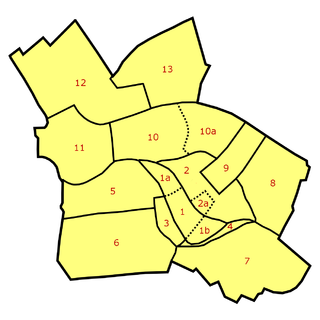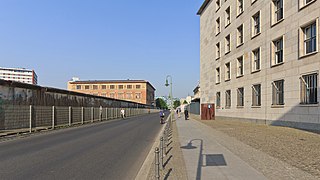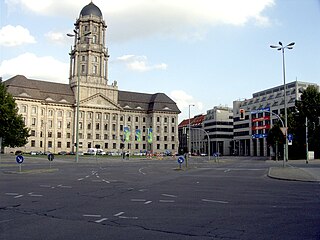
Mönchengladbach is a city in North Rhine-Westphalia, Germany. It is located west of the Rhine, halfway between Düsseldorf and the Dutch border.

Mitte is the first and most central borough of Berlin. The borough consists of six sub-entities: Mitte proper, Gesundbrunnen, Hansaviertel, Moabit, Tiergarten and Wedding.

The Federal Court of Justice is the highest court of civil and criminal jurisdiction in Germany. Its primary responsibility is the final appellate review of decisions by lower courts for errors of law. While, legally, a decision by the Federal Court of Justice is only binding with respect to the individual case in which it enters, de facto the court's interpretation of the law is followed by lower courts with almost no exception. Decisions handed down by the Federal Court of Justice can only be vacated by the Federal Constitutional Court for violating a provision of the German constitution, the Basic Law.

Moabit is an inner city locality in the borough of Mitte, Berlin, Germany. As of 2022, about 84,000 people lived in Moabit. First inhabited in 1685 and incorporated into Berlin in 1861, the former industrial and working-class neighbourhood is fully surrounded by three watercourses, which define its present-day border. Between 1945 and 1990, Moabit was part of the British sector of West Berlin and directly bordered East Berlin.

Cölln was the twin city of Old Berlin (Altberlin) from the 13th century to the 18th century. Cölln was located on the Fisher Island section of Spree Island, opposite Altberlin on the western bank of the River Spree, until the cities were merged by Frederick I of Prussia to form Berlin in 1710. Today, the former site of Cölln is the historic core of the modern Mitte locality of the Berlin-Mitte borough in central Berlin.
Franz Reinhold Schwede was a Nazi German politician, Oberbürgermeister of Coburg and both Gauleiter and Oberpräsident of Pomerania. An early supporter of Adolf Hitler in Coburg, Schwede used intimidation and propaganda to help elect the first Nazi-majority local government in Germany. This contributed to a personality cult surrounding Schwede and he became known as "Franz Schwede-Coburg." During World War II he ordered secret executions of the infirm and mass deportations of Jews. He also played a key role in abandoning the Pomeranian civilian population to the advancing Red Army, while escaping their fate himself. In 1945 he was captured by the British Army and in 1948 he was tried and convicted of war crimes.

Fischerinsel is the southern part of the island in the River Spree which was formerly the location of the city of Cölln and is now part of central Berlin. The northern part of the island is known as Museum Island. Fischerinsel is normally said to extend south from Gertraudenstraße and is named for a fishermen's settlement which formerly occupied the southern end of the island. Until the mid-twentieth century it was a well preserved pre-industrial neighbourhood, and most of the buildings survived World War II, but in the 1960s and 1970s under the German Democratic Republic it was levelled and replaced with a development of residential tower blocks.

Niederkirchnerstraße is a street in Berlin, Germany and was named after Käthe Niederkirchner. The thoroughfare was known as Prinz-Albrecht-Straße until 1951 but the name was changed by the East German government. The street was the location of the SS Reich Security Main Office (RSHA), the headquarters of the Sicherheitspolizei, SD, Einsatzgruppen and Gestapo. The site is now marked by the Topography of Terror memorial and a museum, which includes a permanent exhibition showing the crimes of Nazism.

Leipziger Straße is a major thoroughfare in the central Mitte district of Berlin, capital of Germany. It runs from Leipziger Platz, an octagonal square adjacent to Potsdamer Platz in the west, to Spittelmarkt in the east. Part of the Bundesstraße 1 highway, it is today one of the city's main east–west road links.

The Embassy of the Netherlands in Berlin is the Netherlands's diplomatic mission in Berlin, Germany. Designed by Rem Koolhaas of OMA, the building was opened in 2004.

The Supreme Court of the German Democratic Republic was the highest judicial organ of the GDR. It was set up in 1949 and was housed on Scharnhorststraße 6 in Berlin. The building now houses the district court in Berlin, Germany 2 Instance and the District Court Berlin-Mitte. In the early days, 14 judges made up the court. It was disestablished in 1990.

The Admiralspalast is a theatre on Friedrichstraße in the Mitte district of Berlin, Germany. The theatre has 1,756 seats. It opened in 1910, built as part of a large leisure complex on the former site of the 1873 Admiralsgarten bath house. It is one of the city's few preserved pre-World War II era variety venues.

An Oberlandesgericht is a higher court in Germany.

Marwa Ali El-Sherbini, was an Egyptian woman and German resident who was killed in 2009 during an appeal hearing at a court of law in Dresden, Germany, when she was three months pregnant. She was stabbed by Alex Wiens, an ethnic German immigrant from Russia against whom she had testified in a criminal case for verbal abuse. El-Sherbini's husband, who was present at the hearing, tried to intervene. He too was repeatedly stabbed by Wiens and was then mistakenly shot and wounded by a police officer who was called to the court room. Wiens was arrested at the crime scene and subsequently tried for murder and attempted murder. He was found guilty of both charges; it was also found that Wiens's actions constituted a heinous crime, because they were committed in front of a child, against two people, in a court of law, and fulfilled the murder criterion of treacherousness, such as hatred against foreigners. Wiens was sentenced to life imprisonment.
Erna Scheffler, born Friedental and later Haßlacher was a German senior judge.

Molkenmarkt is the oldest square in Berlin. It is located in the Alt-Berlin quarter of the Mitte district, in the historic centre of the city. With approximately 9,200 square metres (11,000 sq yd) in size, it is today a major traffic junction, dominated by the large Altes Stadthaus administrative building on its southeastern side.
Sachsensumpf is the name given by journalists to a political, judicial and intelligence scandal in the German state of Saxony climaxing in 2007 when domestic intelligence dossiers about the purported implication of judicial and business figures in cases of child prostitution and illegal property deals during the early 1990s became public, raising the suspicion of parts of the state's government and judiciary being corrupted by criminal networks.

Josef Michael Hartinger was a German lawyer who worked for the Bavarian State authorities in the latter years of the Weimar Republic when the Nazis came to power. Tasked with investigating some unnatural deaths at the Dachau concentration camp near Munich, Hartinger together with his medical examiner colleague, Moritz Flamm, discovered the SS policy of summary executions and faked suicides at the camp. At great risk to his own safety, Hartinger issued an indictment of the camp authorities, which was ultimately betrayed and suppressed.

Hermann Karl August Weinkauff was a German jurist. He served in several positions as a judge and later became the first President of the Federal Court of Justice of West Germany.

The Hamburg Regional Court is a court of ordinary jurisdiction and the only regional court in the district of the Hanseatic Higher Regional Court based in Hamburg. The first woman to head the Hamburg Regional Court was Konstanze Görres-Ohde, who held office from 1996 to 2001. Sibylle Umlauf was president from 2009 until her retirement on March 31, 2018. Marc Tully headed the court from September 2018 to November 2020.


















